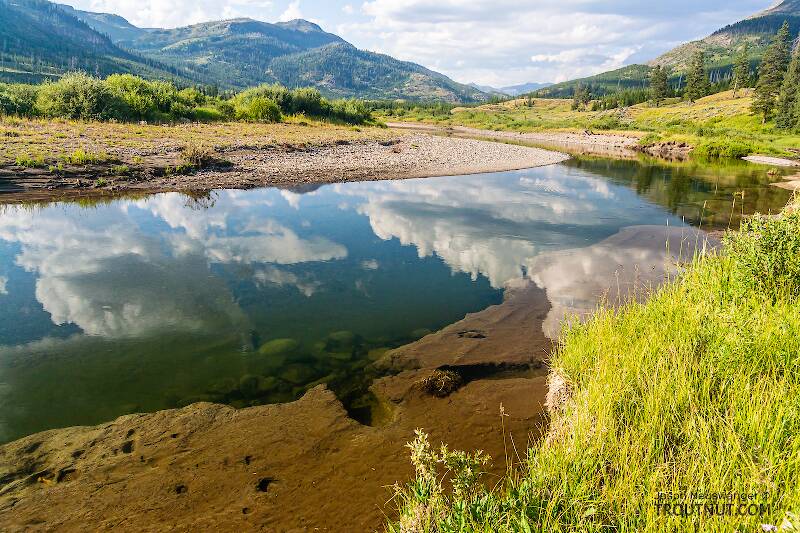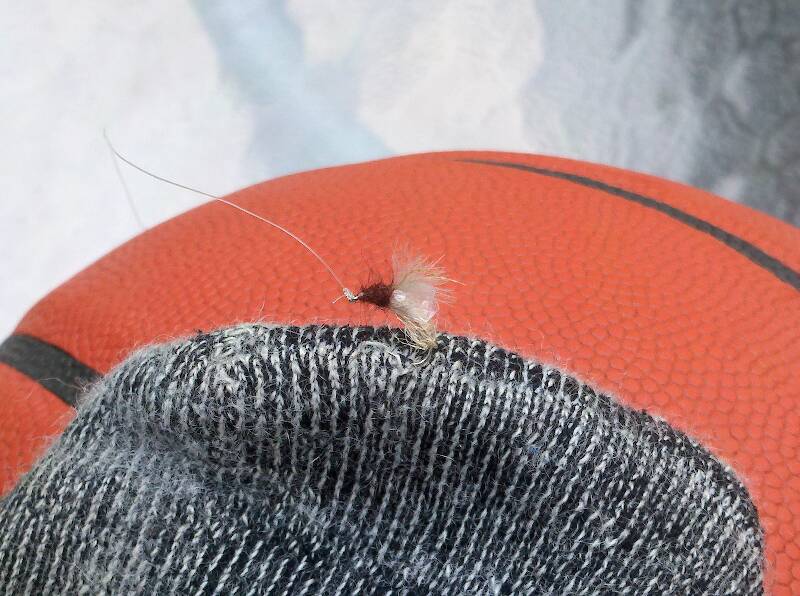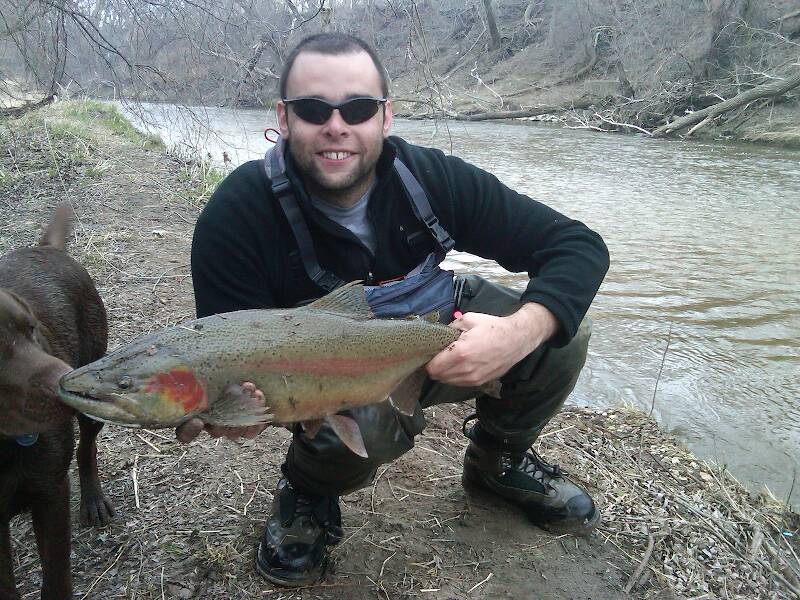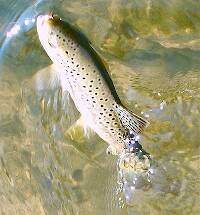
Blue-winged Olives
Baetis
Tiny Baetis mayflies are perhaps the most commonly encountered and imitated by anglers on all American trout streams due to their great abundance, widespread distribution, and trout-friendly emergence habits.
Featured on the forum

Troutnut is a project started in 2003 by salmonid ecologist Jason "Troutnut" Neuswanger to help anglers and
fly tyers unabashedly embrace the entomological side of the sport. Learn more about Troutnut or
support the project for an enhanced experience here.
TKB on Mar 30, 2015March 30th, 2015, 10:17 am EDT
I am new to this group, but I'd like to start a discussion thread if that is ok......I am of the opinion that it is a colossal waste of time to fish a dry fly during an active caddis hatch. I have rarely taken a fish on the surface during one and have had much more success using an emerger.
Oldredbarn on Mar 30, 2015March 30th, 2015, 11:02 am EDT
I am new to this group, but I'd like to start a discussion thread if that is ok......I am of the opinion that it is a colossal waste of time to fish a dry fly during an active caddis hatch. I have rarely taken a fish on the surface during one and have had much more success using an emerger.
TKB...You been reading Bob Wyatt? :) Never mind, I'll stay away from that one. :)
If you will forgive me, the post that you propose is a bit of a no-brainer. The emerger is near the top in the eating order for the trout right after the pupae that are taken under the surface.
Are you including the X-Caddis in the emerger category? Tied on a straight hook most of the fly is riding on the surface...I have caught fish on a dry version of the caddis during a hatch, but percentage wise you would be correct...IMHO. Though "colossal waste of time" may be a tad too extreme. :)
Egg layers are interesting as well since we have some caddis that make it under the surface to deposit their eggs.
Spence
Oh...Well to the forum...Just what we needed, another one of those "Pennsylvania Boys"! :)
"Even when my best efforts fail it's a satisfying challenge, and that, after all, is the essence of fly fishing." -Chauncy Lively
"Envy not the man who lives beside the river, but the man the river flows through." Joseph T Heywood
"Envy not the man who lives beside the river, but the man the river flows through." Joseph T Heywood
Kschaefer3 on Mar 30, 2015March 30th, 2015, 11:05 am EDT
I fish an elk hair caddis with good results during caddis hatches on the spring creeks I frequent. Maybe the fish are just dumb....or maybe I'm just dumb...
MiltRPowell
Posts: 106
Posts: 106
MiltRPowell on Mar 30, 2015March 30th, 2015, 11:32 am EDT
Yeah, I have ta go with, maybe the fish are just dumb....or maybe I'm just dumb...
But I thought I heard the dry fly fishing and caddis hatching in Pa,? on the Little J.??? was good.???
Ah, good ????? for some of the Pa. boys, I'm going with the, I'm dumb, but I fish the elk now & then on the creeks myself. Works in N.Y.
But I thought I heard the dry fly fishing and caddis hatching in Pa,? on the Little J.??? was good.???
Ah, good ????? for some of the Pa. boys, I'm going with the, I'm dumb, but I fish the elk now & then on the creeks myself. Works in N.Y.
flyfishingthecreekM.R.P.
TKB on Mar 30, 2015March 30th, 2015, 12:03 pm EDT
I'm convinced they ignore the caddis on the surface and prefer the emergers...
Wbranch on Mar 30, 2015March 30th, 2015, 12:07 pm EDT
TKB,
I would tend to agree with you on this remark. I have fished two rivers with blinding caddis emergences. The lower Beaverkill in May gets a phenomenal emergence of what we call the "Shad Fly". It is a caddis fly about a #14 - #16 with gray mottled wings, an short olive body, and a bright green egg sack. The other caddis is the "Apple Caddis" and I find that in epic numbers on the West Branch of the Delaware. It is about a #16 - #18, with blond color wings, and a bright green abdomen. On both rivers I've seen thousands of bugs, coming on waves, about 1/2 hour apart, all day long. I've seen hundreds of rising fish, or should I say "boiling" fish and not eating the adults. I've seen dozens and dozens of adults go floating over big "boiling or bulging" fish only to be totally ignored.
Once in a blue moon, and if I'm very stubborn, and can put an adult fly over a feeding fish over and over, I might get the trout to rise. But if I trail a pupa that represents the natural caddis on a short dropper behind the dry fly I will get many takes. So I continue to throw the dry fly but add a pupa behind it to increase my strikes.
I am new to this group, but I'd like to start a discussion thread if that is ok......I am of the opinion that it is a colossal waste of time to fish a dry fly during an active caddis hatch. I have rarely taken a fish on the surface during one and have had much more success using an emerger.
I would tend to agree with you on this remark. I have fished two rivers with blinding caddis emergences. The lower Beaverkill in May gets a phenomenal emergence of what we call the "Shad Fly". It is a caddis fly about a #14 - #16 with gray mottled wings, an short olive body, and a bright green egg sack. The other caddis is the "Apple Caddis" and I find that in epic numbers on the West Branch of the Delaware. It is about a #16 - #18, with blond color wings, and a bright green abdomen. On both rivers I've seen thousands of bugs, coming on waves, about 1/2 hour apart, all day long. I've seen hundreds of rising fish, or should I say "boiling" fish and not eating the adults. I've seen dozens and dozens of adults go floating over big "boiling or bulging" fish only to be totally ignored.
Once in a blue moon, and if I'm very stubborn, and can put an adult fly over a feeding fish over and over, I might get the trout to rise. But if I trail a pupa that represents the natural caddis on a short dropper behind the dry fly I will get many takes. So I continue to throw the dry fly but add a pupa behind it to increase my strikes.
Catskill fly fisher for fifty-five years.
MiltRPowell
Posts: 106
Posts: 106
MiltRPowell on Mar 30, 2015March 30th, 2015, 12:36 pm EDT
Wbranch, I am gonna try that, the pupa short dropper.
I just come into some nice ones, getting smarter already. That is one thing I am looking to do this year, more droppers, & some tied tagged flies. Never fished a tagged, don't know why, maybe things change when you meet newer fly guys. But I now know others that fish this way at times..... They say works well.
I just come into some nice ones, getting smarter already. That is one thing I am looking to do this year, more droppers, & some tied tagged flies. Never fished a tagged, don't know why, maybe things change when you meet newer fly guys. But I now know others that fish this way at times..... They say works well.
flyfishingthecreekM.R.P.
RleeP on Mar 30, 2015March 30th, 2015, 1:32 pm EDT
>>I am of the opinion that it is a colossal waste of time to fish a dry fly during an active caddis hatch.>>
Sometimes. Sometimes, not... It depends on a pile of variables.
In general, my experience has been most like Kyle's.
Sometimes. Sometimes, not... It depends on a pile of variables.
In general, my experience has been most like Kyle's.
Crepuscular on Mar 30, 2015March 30th, 2015, 1:43 pm EDT
I am new to this group, but I'd like to start a discussion thread if that is ok......I am of the opinion that it is a colossal waste of time to fish a dry fly during an active caddis hatch. I have rarely taken a fish on the surface during one and have had much more success using an emerger.
TKB, welcome, and a good discussion is always welcome. I find that it is very limiting to make broad generalizations about trout feeding behavior and insect biology. My thoughts on your statement that it is colossal waste of time to fish a dry fly during a caddis emergence is that you are making way too broad of a statement, and certainly there are times when you may not be able to coax a fish into rising for your dry fly. But I would also say that there are times when the opposite is true. It comes back to presentation, and fly selection. I catch fish on dry flies very often (but not always) during a caddis hatch, be it grannoms (Brachycentrus sp.) to the big Pyncnopsyche sp. hatches in the fall. Now I will say that at certain times, there are certain behaviors of a caddis that are more difficult to mimmic with a dry fly, and yes at certain stages of a caddis emergence, a subsurface pattern may be more effective, but it is really hard to ignore the effectiveness of quite a few floating caddis patterns. Like the gentleman from Michigan said the X-Caddis is an extremely effective floating caddis pattern, that is in my opinion, a dry fly, after all it floats on the surface. Also how can anyone dispute the effectiveness of the X-Caddis' predecessor the elk hair caddis and the cdc and elk, those flies have taken an incredible amount of fish. For example, the last two years on Penns Creek I have had wonderful fishing during the grannom emergence using a floating fly, sight fished to individual rising fish. This example is offered up not as a blanket statement trying to prove you wrong, but just as an instance that supports my point just as I'm sure you can supply instances that support yours. In fishing and entomology, I never say never or always... :)
Eric
Lastchance on Mar 30, 2015March 30th, 2015, 2:32 pm EDT
TKB, welcome to the forum. We've got some nice, knowledgeable people here. I was of the same opinion as you especially during the grannom hatch. I hooked very few fish on the surface during that hatch. I do believe one catches more fish below the surface during a caddis hatch. But, a funny thing happened a few years ago. I began fishing with some erudite bug guys that are very experienced. At that time I began to realize I just didn't know enough about caddis flies, period. I mean no disrespect to you. As my ego allowed me to become a student again, my success with the hatch rose. Just my thoughts.
PaulRoberts on Mar 30, 2015March 30th, 2015, 4:58 pm EDT
Agreed with the others -there's more to the game than blanket statements can cover. Some species produce good dry fly fishing, others almost never.
As to Spence's reference to Bob Wyatt... I think he is right on in many respects... but let's not make that a blanket statement. He's a hatch-matcher too -we don't always get to have our own way out there- he's just not bought into the Nth+1 degree some anglers get funneled down. Sometimes fish are taking, or not taking, our flies for reasons that we haven't considered, or maybe for different and far simpler reasons than we attribute.
As to Spence's reference to Bob Wyatt... I think he is right on in many respects... but let's not make that a blanket statement. He's a hatch-matcher too -we don't always get to have our own way out there- he's just not bought into the Nth+1 degree some anglers get funneled down. Sometimes fish are taking, or not taking, our flies for reasons that we haven't considered, or maybe for different and far simpler reasons than we attribute.
TKB on Mar 30, 2015March 30th, 2015, 5:12 pm EDT
What a great discussion! A blanket statement, just like a blanket, can be warm and cozy. It can also spur a discussion that teases out really awesome nuggets of information. I am so appreciative of all your knowledge, shared freely. Rleep said it best "Sometimes. Sometimes, not... It depends on a pile of variables.". And that is why I fly fish. When you think you've got it figured out, boom....the pile of variables rises up and hits you square in the face.
However, I'll still bias my fly tying to caddis nymph and emerger patterns at the expense of adult patterns. Besides, that Goddard Caddis did real damage to my big toe....
However, I'll still bias my fly tying to caddis nymph and emerger patterns at the expense of adult patterns. Besides, that Goddard Caddis did real damage to my big toe....
Wbranch on Mar 30, 2015March 30th, 2015, 5:32 pm EDT
Eric,
Possibly one may be able to coax a fish into rising. But as much as I prefer to fish dry and have a fish eat the dry fly I find there are periods of diminishing returns to persist with the dry fly when they eat it so seldom. I fly fish for fun and prefer to fish dry but I don't enjoy standing out there hour after hour throwing a dry caddis to no avail. I want to feel the tug so putting the pupa behind the dry improves my odds and maybe I will get one on the dry.
My experience with other waters is extremely limited. I'm sure there are plenty of rivers where the trout do rise well to caddis adults. I have had similar experiences in Montana with PMD adults. On the Big Horn the trout never hesitate to eat a well floated dun yet on the Missouri (BTW both are true tailwaters) the trout rarely eat the duns, and not just do they ignore my duns, but the duns of many of my friends who are at least my equal on the water.
My thoughts on your statement that it is colossal waste of time to fish a dry fly during a caddis emergence is that you are making way too broad of a statement, and certainly there are times when you may not be able to coax a fish into rising for your dry fly.
Possibly one may be able to coax a fish into rising. But as much as I prefer to fish dry and have a fish eat the dry fly I find there are periods of diminishing returns to persist with the dry fly when they eat it so seldom. I fly fish for fun and prefer to fish dry but I don't enjoy standing out there hour after hour throwing a dry caddis to no avail. I want to feel the tug so putting the pupa behind the dry improves my odds and maybe I will get one on the dry.
My experience with other waters is extremely limited. I'm sure there are plenty of rivers where the trout do rise well to caddis adults. I have had similar experiences in Montana with PMD adults. On the Big Horn the trout never hesitate to eat a well floated dun yet on the Missouri (BTW both are true tailwaters) the trout rarely eat the duns, and not just do they ignore my duns, but the duns of many of my friends who are at least my equal on the water.
Catskill fly fisher for fifty-five years.
PaulRoberts on Mar 30, 2015March 30th, 2015, 5:34 pm EDT
However, I'll still bias my fly tying to caddis nymph and emerger patterns at the expense of adult patterns.
I think that's an appropriate bias. However... :)
PaulRoberts on Mar 30, 2015March 30th, 2015, 5:39 pm EDT
I have had similar experiences in Montana with PMD adults. On the Big Horn the trout never hesitate to eat a well floated dun yet on the Missouri (BTW both are true tailwaters) the trout rarely eat the duns, and not just do they ignore my duns, but the duns of many of my friends who are at least my equal on the water.
Matt, I've not fished either, but, would one have more riffly water surfaces, and the other flatter, even slower? Just curious.
Wbranch on Mar 30, 2015March 30th, 2015, 6:20 pm EDT
Paul,
The Big Horn, from the After Bay dam down river to the Thirteen Mile access does have a much more diverse flow regime than the Missouri which for the most part is a series of very long flats interspersed with some short riffle water. However I always preferred to fish the flatter water of both rivers and the trout ignore the duns, on the flat water of the Missouri, while they eat them heartily on the Big Horn. Go figure. Maybe it is just the sheer plethora of nymphs and emergers found on the Missouri that a the trout say "Hmm why do I want to rise and stick my nose out of the water so I might be eaten by a raptor or a pelican when I can be shy and demure and eat underwater like my mother taught me?"
Here is one of my pupa ties;
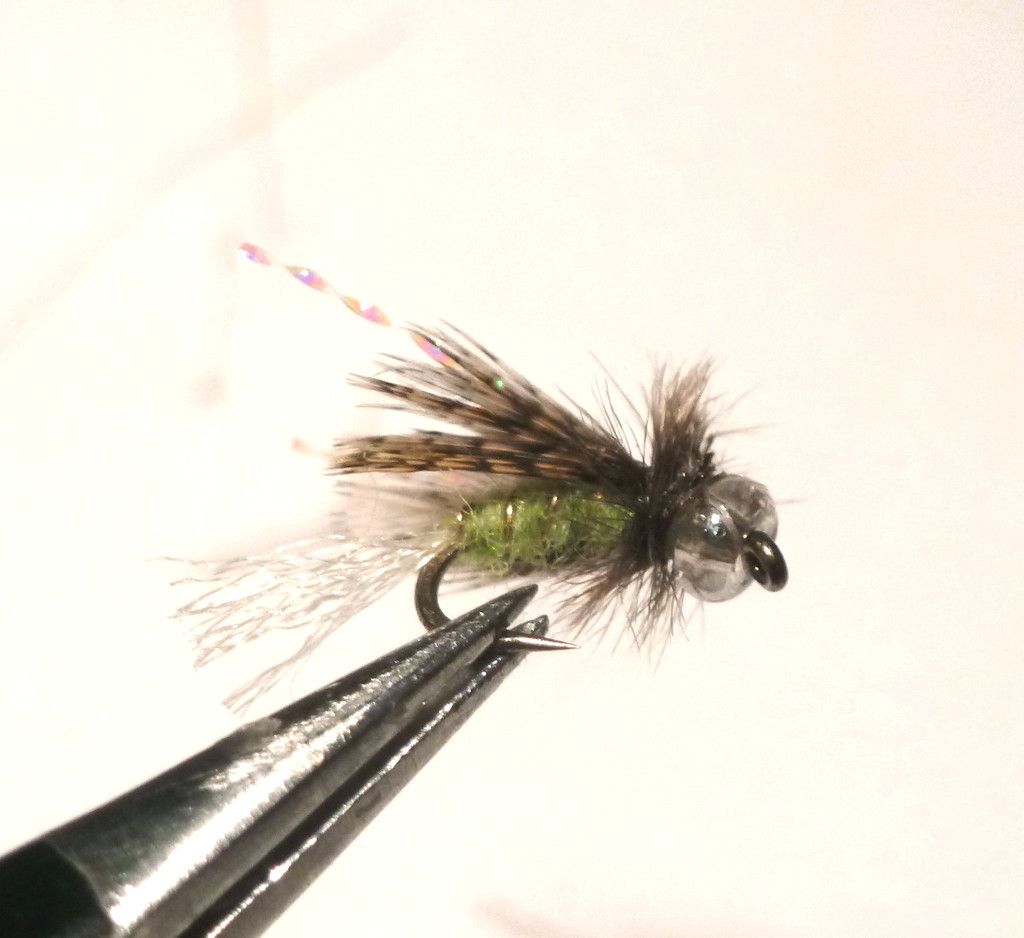
Same fly different abdomen color; Both are on #18 scud hooks

Some other Apple caddis pupa tied with tan Swiss Straw wings and smoother abdomen.

The Big Horn, from the After Bay dam down river to the Thirteen Mile access does have a much more diverse flow regime than the Missouri which for the most part is a series of very long flats interspersed with some short riffle water. However I always preferred to fish the flatter water of both rivers and the trout ignore the duns, on the flat water of the Missouri, while they eat them heartily on the Big Horn. Go figure. Maybe it is just the sheer plethora of nymphs and emergers found on the Missouri that a the trout say "Hmm why do I want to rise and stick my nose out of the water so I might be eaten by a raptor or a pelican when I can be shy and demure and eat underwater like my mother taught me?"
Here is one of my pupa ties;

Same fly different abdomen color; Both are on #18 scud hooks

Some other Apple caddis pupa tied with tan Swiss Straw wings and smoother abdomen.

Catskill fly fisher for fifty-five years.
TKB on Mar 30, 2015March 30th, 2015, 6:36 pm EDT
Not an expert but I agree with Matt, fish will take the easy,safe way to eat. Less energy expended, less exposure to predation seems to work for them. When I see the porpoising rise, I tie on the soft hackle/EMOC (Emerger Of Choice)pattern.
Now if I could convince them to consistently take a 14 over a 22, all would be right with the world......
Now if I could convince them to consistently take a 14 over a 22, all would be right with the world......
PaulRoberts on Mar 30, 2015March 30th, 2015, 6:57 pm EDT
Paul,
The Big Horn, from the After Bay dam down river to the Thirteen Mile access does have a much more diverse flow regime than the Missouri which for the most part is a series of very long flats interspersed with some short riffle water. However I always preferred to fish the flatter water of both rivers and the trout ignore the duns, on the flat water of the Missouri, while they eat them heartily on the Big Horn. Go figure. Maybe it is just the sheer plethora of nymphs and emergers found on the Missouri that a the trout say "Hmm why do I want to rise and stick my nose out of the water so I might be eaten by a raptor or a pelican when I can be shy and demure and eat underwater like my mother taught me?"
That's a very Bob Wyatt type of comment right there.
Nice flies, too.
Wbranch on Mar 30, 2015March 30th, 2015, 7:12 pm EDT
Hi Paul,
Thanks for the kind words about my ties. I live under a rock, in a cave, and have not the slightest clue who Bob Wyatt is. Is he an author of fly fishing books?
Thanks for the kind words about my ties. I live under a rock, in a cave, and have not the slightest clue who Bob Wyatt is. Is he an author of fly fishing books?
Catskill fly fisher for fifty-five years.
Jmd123 on Mar 30, 2015March 30th, 2015, 8:48 pm EDT
Just my usual two cents worth, but the good old EHC (Elk-hair caddis) works well for me on many an occasion, but your results may differ...even had one work last year during the Nectopsyche hatch, which can be particularly frustrating since the flies never seem to touch the water!
Jonathon
Jonathon
No matter how big the one you just caught is, there's always a bigger one out there somewhere...
Quick Reply
Related Discussions
Topic
Replies
Last Reply
2
Jul 9, 2018
by Martinlf
by Martinlf

